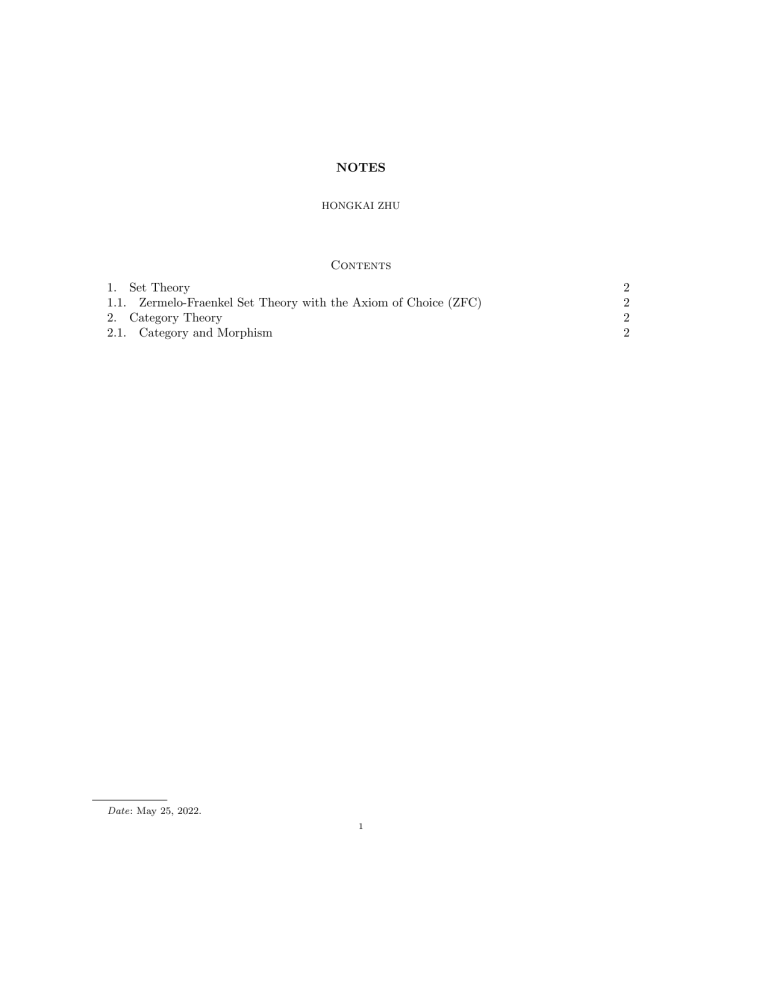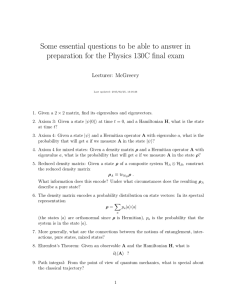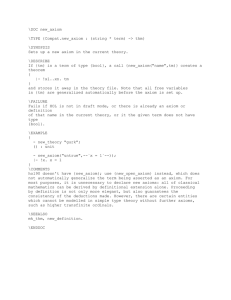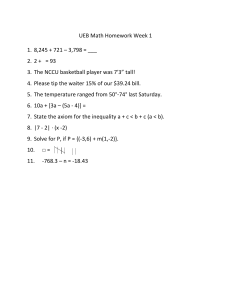
NOTES
HONGKAI ZHU
Contents
1. Set Theory
1.1. Zermelo-Fraenkel Set Theory with the Axiom of Choice (ZFC)
2. Category Theory
2.1. Category and Morphism
Date: May 25, 2022.
1
2
2
2
2
2
HONGKAI ZHU
1. Set Theory
1.1. Zermelo-Fraenkel Set Theory with the Axiom of Choice (ZFC).
Axiom 1 (Axiom of Extensionality). Two sets are equal if they have the same elements.
Axiom 2 (Axiom of Pairing). For every x, y, there exists a set x, y which contains x and y as
elements.
Axiom 3 (Axiom Schema of Specification (separation/restricted comprehension)). Suppose R is
a property of sets, and P (u) represents a set u have the property P , then for every set X, there
exists a set Y = {u ∈ X : P (u)}.
!
Axiom 4 (Axiom of Union). For every set X, there exists a corresponding union X : {u : u ∈
v for some v ∈ X}.
Axiom 5 (Axiom of Power Set). For every set X, its subset forms a set P (X) : {u : u ⊂ X}.
Axiom 6 (Axiom of Infinity). There exists infinity sets.
Axiom 7 (Axiom of Schema of Replacement). Suppose F is a function of X as domain, then there
exists a set F (x) = {F (x) : x ∈ X}.
Axiom 8 (Axiom of Regularity). Any nonempty set contains a membership ∈ minimal element.
Axiom 9 (Axiom of
! Choice). Suppose every element in the set X is nonempty, then there exists
a function g : X → X such that g(x) ∈ x for every x ∈ X. g is a choice function.
2. Category Theory
2.1. Category and Morphism.
Definition 1. A category C is
(i) A collection of objects Ob(C).
(ii) To any two objects N, M ∈ Ob(C) there is attached a set HomC (N, M ) which is called the
set of morphisms between these two objects.
(iii) For any three objects N, M, P we have the composition of morphisms
HomC (N, M ) × HomC (M, P ) → HomC (N, P )
(φ, ψ) %→ φ ◦ ψ.
(iv) For any object N ∈ Ob(C) we have a distinguished element IdN ∈ HomC (N, N ), which is
an identity on both sides under the composition.
Usually we denote a morphism φ ∈ HomC (N, M ) by an arrow φ : N → M .
If a morphism η is a composition of φ and ψ then we denote this by a commutative diagram
(or commutative triangle)
φ
M
N
η
ψ
P






